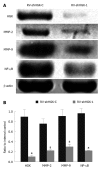Lowered HGK expression inhibits cell invasion and adhesion in hepatocellular carcinoma cell line HepG2
- PMID: 20857524
- PMCID: PMC2945485
- DOI: 10.3748/wjg.v16.i36.4541
Lowered HGK expression inhibits cell invasion and adhesion in hepatocellular carcinoma cell line HepG2
Abstract
Aim: To investigate the effects of RNA interference targeting hepatocyte progenitor kinase-like kinase (HGK) in the invasion and adhesion of hepatocellular carcinoma (HCC) cell line HepG2.
Methods: Three paired insert DNA fragments specific to HGK gene and one negative control DNA fragment were synthesized and inserted into RNAi-Ready pSIREN-RetroQ-ZsGreen vector. Western blotting assay and real-time reverse transcriptase polymerase chain reaction (RT-PCR) were used to screen the vector with a highest inhibitory rate. The vector was used to generate recombinant retrovirus specific to HGK. 3-(4,5-dimethylthiazol-2-yl)-2,5-diphenyl-2h-tetrazolium bromide (MTT) assay was used to examine cell growth; wound closure assay and cell adhesion assay were employed to investigate cell migration and adhesion respectively; and transwell assay and three-dimensional culture invasion assay were used to detect cell invasion. The expressions of matrix metalloproteinase (MMP)-2, MMP-9 and nuclear factor (NF)-κB were detected by Western blotting assay.
Results: The real time RT-PCR and Western blotting assay showed that cells transfected with retrovirus mediating RNAi targeting of HGK (RV-shHGK)-1 vector had the strongest inhibition of HGK protein, with an inhibition rate of 76%, and this vector was used to generate recombinant retrovirus RV-shHGK-1. Cell adhesion assay and MTT assay found that cell adhesion and growth of the cells infected with RV-shHGK-1 were significantly lower than those of the control cells (P < 0.05). Wound closure assay, transwell assay and three-dimensional culture invasion assay showed that the cell invasiveness was significantly less in HGK knockdown cells than in the control cells (P < 0.05). The expressions of MMP-2, MMP-9 and NF-κB were inhibited in HepG2 cells infected with RV-shHGK-1.
Conclusion: Down-regulation of HGK can obviously inhibit the migration and invasion of HepG2 cells in vitro. HGK may be a new therapeutic target for treatment of HCC.
Figures





References
-
- Parkin DM, Bray F, Ferlay J, Pisani P. Global cancer statistics, 2002. CA Cancer J Clin. 2005;55:74–108. - PubMed
-
- Urzúa U, Roby KF, Gangi LM, Cherry JM, Powell JI, Munroe DJ. Transcriptomic analysis of an in vitro murine model of ovarian carcinoma: functional similarity to the human disease and identification of prospective tumoral markers and targets. J Cell Physiol. 2006;206:594–602. - PubMed
Publication types
MeSH terms
Substances
LinkOut - more resources
Full Text Sources
Other Literature Sources
Medical
Miscellaneous

